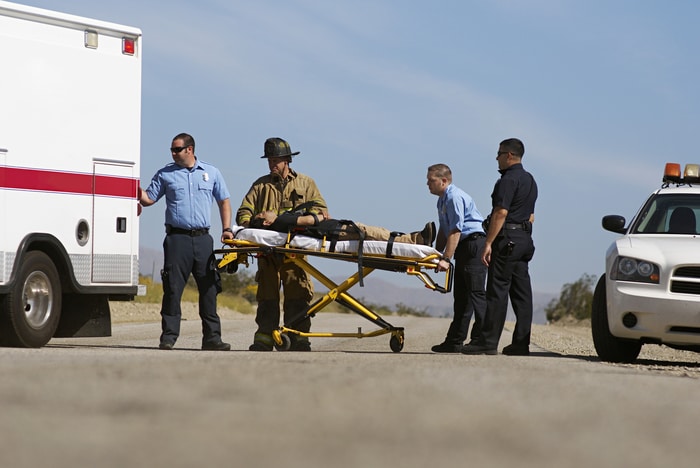
There are many medical and traumatic causes for a decreased level of consciousness, any of which can lead to a respiratory emergency. A thorough patient assessment and quick diagnosis, followed by aggressive treatment, can prevent the patient's condition from deteriorating. But even optimal care cannot stave off every respiratory complication.
So, today we'll review some of the common causes of decreased level of consciousness to help prevent subsequent respiratory emergencies.
Gauging Level of Consciousness
We are all familiar with the Glasgow Coma Scale, but it never hurts to review the individual parameters. An overall score is not as useful as the individual values for describing the patient's condition, so here's a quick refresher:
Best Eye Response
- No eye opening
- Eye opening to pain
- Eye opening to verbal command
- Eyes open spontaneously
Best Verbal Response
- No verbal response
- Incomprehensible sounds
- Inappropriate words
- Confused
- Oriented
Best Motor Response
- No motor response
- Decerebrate posture (arms and legs extended, rigid, head and neck arched backward)
- Decorticate posture (rigidity, arms bent toward body, legs straight)
- Withdrawal from pain
- Localizing pain
- Obeys commands
Children and Infants
For children and infants, you must use a tailored scale. Because not all of the adult parameters are suited for these groups, the Pediatric Glasgow Coma Scale is used.
Eye Opening
- None
- To pain
- To voice
- Spontaneous
Verbal Response
- None
- Inconsistently inconsolable, moaning
- Inconsolable, agitated
- Cries but consolable, inappropriate interactions
- Smile, oriented to sounds, follows objects, interacts
Motor Response
- None
- Decerebrate posture
- Decorticate posture
- Withdraws from pain
- Withdraws from touch
- Moves spontaneously or purposefully
Eye Opening
- None
- To pain
- To voice
- Spontaneous
Verbal Response
- None
- Moans, grunts to pain, restless
- Persistent cries or screams
- Irritable but consolable
- Coos, babbles
Motor Response
- None
- Decerebrate posture
- Decorticate posture
- Withdraws from pain
- Withdraws from touch
- Moves spontaneously or purposefully
Now that we've reviewed the coma scales, we'll discuss a few common causes of decreased level of consciousness and how they can lead to respiratory emergencies.
Causes of a decreased level of consciousness
Hypoglycemia
The body depends on glucose as its main energy source. When the blood sugar falls below the normal range (70–120 mg/deciliter), the patient begins to exhibit signs, including:
- Heart palpitations
- Fatigue
- Pale skin
- Shakiness
- Anxiety
- Sweating
- Hunger
- Irritability
- Tingling sensation around the mouth
- Crying out during sleep
If left unchecked, the hypoglycemia can worsen, as can the signs and symptoms. In severe cases, the patient will experience:
- Confusion and/or abnormal behavior
- Visual disturbances, such as blurred vision
- Seizures
- Loss of consciousness
With seizures and loss of consciousness, the patient may become hypoxic. To control the airway, begin by positioning the patient to maintain patency and facilitate drainage of bodily fluids away from the respiratory tract. Secure the airway with an EOA or endotracheal tube and perform oropharyngeal suction to keep the airway clear.
Alcohol Poisoning
Alcohol poisoning occurs when levels of alcohol in the bloodstream rise to the point that the brain’s basic life-support functions, such as breathing, heart rate, and temperature, begin to shut down. Symptoms of alcohol poisoning include:
- Confusion
- Decreased level of consciousness
- Vomiting
- Seizures
- Dyspnea
- Bradycardia
- Clammy, cyanotic skin
- Diminished responses (loss of gag reflex)
- Hypothermia
What makes alcohol poisoning so prone to becoming a respiratory emergency is the lethal combination of symptoms. Alcohol not only diminishes the gag reflex but also irritates the stomach, which can cause vomiting. For the unconscious person, this can lead to choking, aspiration, and eventually death.
Hemorrhagic Stroke
Although hemorrhagic stroke is less common than ischemic stroke, both can produce life-altering brain injuries. Hemorrhagic stroke is most commonly caused by uncontrolled hypertension, but other causes include:
- Trauma
- Ruptured aneurysm
- Use of blood thinners
- Bleeding tumors
- Drug use, such as cocaine or methamphetamines, which can cause severe hypertension
- Bleeding disorders, such as hemophilia or sickle-cell anemia
- Arteriovenous malformations, which disrupt normal blood flow
As with any brain injury, a decreased level of consciousness—even unconsciousness—is common. Be prepared to treat respiratory emergencies in such patients. Depending on where the bleeding occurs, the patient may suffer paralysis and be unable to maintain a patent airway. It is your job to guard against a respiratory emergency. And patients suffering from brain bleeds are at extreme risk.
No matter the cause, patients with decreased level of consciousness can easily result in a respiratory emergency, if not properly protected and aggressively treated. So, remain alert in such situations and be sure to keep the portable suction unit at the ready.
Editor's Note: This blog was originally published in November of 2017. It has been re-published with additional up to date content.
















